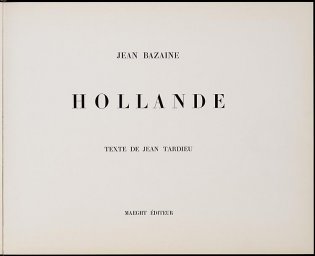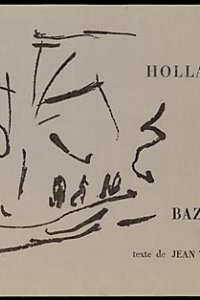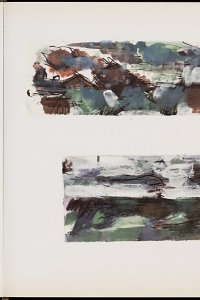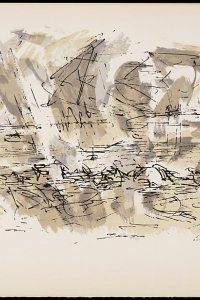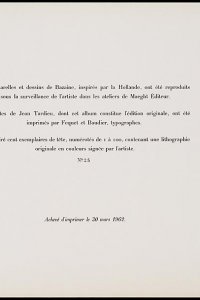Hollande
Year: 1962
Author: Jean Tardieu (1903 - 1995)
Artist: Jean Bazaine (1904 - 2001)
Publisher: Maeght éditeur
The poet Tardieu
Before he opted for a career as an artist, Bazaine had studied philosophy, literature, and art history at the Sorbonne; he always kept his affinity for literature. From 1942 onwards he was part of the entourage of Georges Bataille, Paul Eluard and Raymond Queneau. He met Jean Tardieu in these circles. Tardieu (Daniel Tevoux's pseudonym) hailed from the Jura valley and studied philology in Paris. He started publishing volumes of poetry in the 1930s, and plays in the 1950s, such as Un mot pour autre (1951) and Les amants du métro (1952). These were one-act plays in the surrealist and absurdist tradition, with vivid, enigmatic dialogues that were also suitable for the café-theatres. From the war until his retirement, Tardieu occupied high-placed positions in radio and television. He continued to write poems, essays, memoirs and plays.
The specific combination of the sound of a word with an image or presentation formed an important cornerstone for Tardieu's art. 'All the windows open at once, and in a single leap I transcend all my limitations' is the first sentence in Hollande. This book is actually one long poem, divided into 'themes', some of which are made up of endlessly long, associative sentences, the meaning of which is felt rather than understood rationally. These themes are printed in roman type: each is commented on or further elaborated in italics. A few 'sound poems' have also been included. They deal purely with the musical sound of words strung together like a chain:
large largue lave
délie ébroue surgi salubre hume
arbore cataracte dérive horreur ravir ouragan
Publisher Maeght
The publisher of Hollande was Aimé Maeght, with whom Jean Bazaine had been in contact since the late 1940s: he exhibited his work regularly with this multi-faceted and famous gallery owner from 1949 onwards. Aimé Maeght (1906-1982) began his career as a lithographer for a printer. His reputation in the art world was the result of exhibitions he and his wife Marguérite Devaye (1909-1977) organised in their galleries, first in Cannes and later in Paris, where the swift rise of the Galerie Maeght in the Rue de Téhéran coincided with Aimé's development into an 'éditeur d'art'.
This second calling eventually overshadowed his first occupation. Maeght never made a secret of the fact that he preferred to be remembered as a publisher of modern art. The Éditions Maeght functioned from the very start as a 'trait d’union' between poetry and the graphic arts. Many artists became world-famous thanks to him: Georges Braque, Giacometti, Alexander Calder, Bram van Velde, Juan Miró and Marc Chagall. Their work was often produced based on friendship and trust, with each artist contributing his work in complete freedom. Hollande is another example of a fortunate collaboration between writer, graphic artist and publisher.
Bibliographical description
Description: Hollande / [aquarelles et dessins de] Jean Bazaine ; texte de Jean Tardieu. - Éd. orig. - Paris : Maeght éditeur, 1962. - [36] p. : ill. ; 31×38 cm
Printer: Aimé Maeght (aquarelles, drawings), Fequet et Baudier (text)
Edition: 100 copies
This copy: Number 25 of 100
Note: With original colour lithograph, signed by Jean Bazaine
Bibliography: Bénézit 1-907 ; Monod-10580
Shelfmark: KW Koopm E 42
References
- Jean-Yves Debreuille, Lire Tardieu. Lyon, Presses Universitaires de Lyon, 1988
- Jean Tardieu. Paris, Seghers, 1964
- Lydia Harambourg, L' École de Paris, 1945-1965: Dictionnaire des peintres.Neuchâtel, Ides & Calendes, 1993
- Jean-Louis Prat, L' univers d'Aimé et Marguerite Maeght. Saint-Paul, Fondation Maeght, 1982
- C. Tacou, F. Dax-Boyer, Jean Tardieu. Paris, Éditions de l'Herne, 1991
